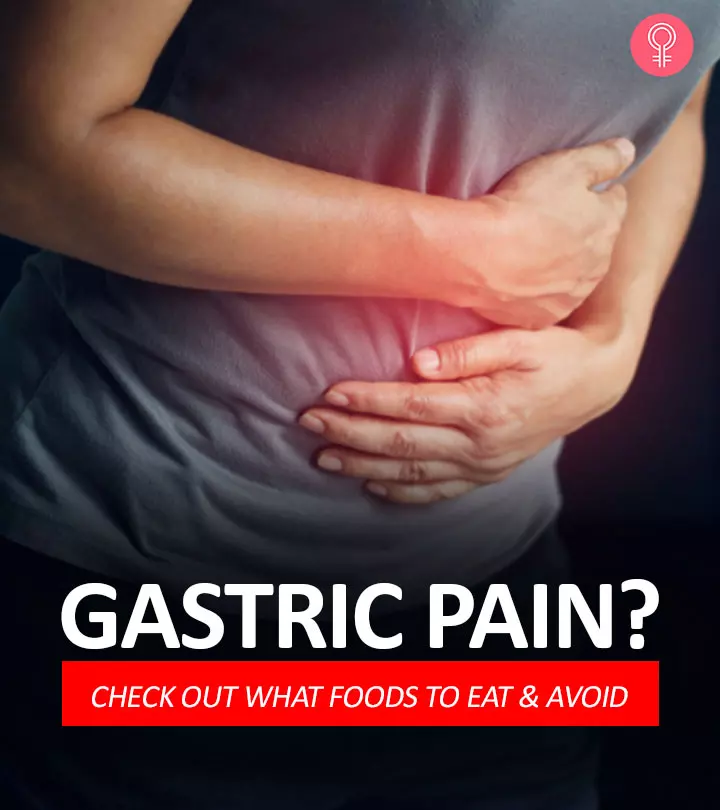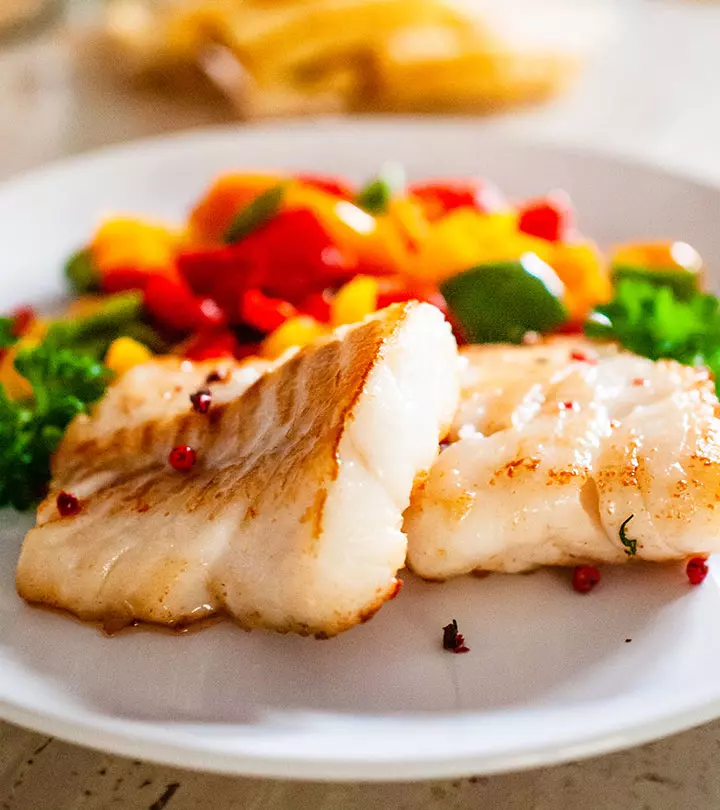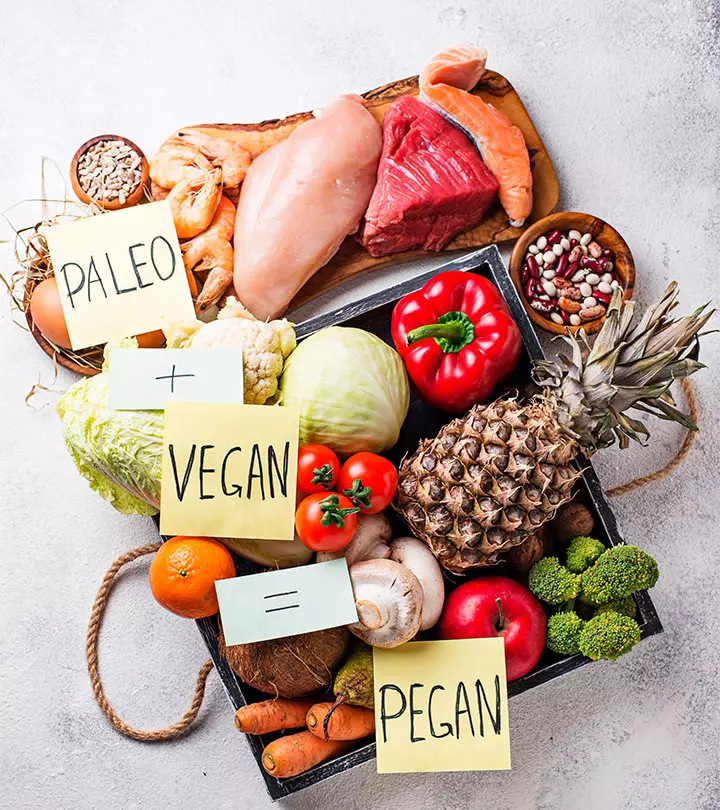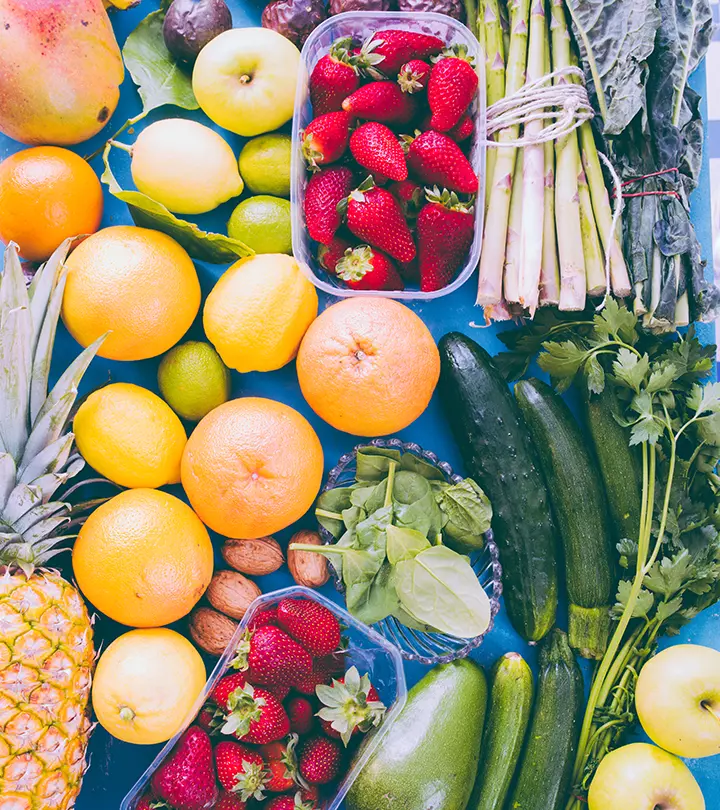One-Meal-A-Day (OMAD) Diet: Benefits & Foods To Eat And Avoid
This popular fasting method benefits your weight loss goals, but beware of its risks.

Image: Shutterstock
The one meal a day diet or OMAD is quickly gaining popularity. It is a form of intermittent fasting that allows you to consume only one meal per day (and not 5 or 6 meals a day). If you want to lose weight, you must give OMAD diet a try. Here, you will have a one-hour window to eat anything you want without any restrictions. However, you will fast for the next 23 hours. The scientists from the University of California found that fasting helps lower blood sugar and cholesterol, improves metabolism, and increases the number of good gut bacteria (1).
Clearly, alternate-day fasting or fasting twice a week will help you lose weight as well as improve your wellbeing. Here’s your ultimate guide to the OMAD diet, how it will work for you, what to eat, what foods to avoid, and the dos and don’ts. Take a look!
 At A Glance: One-Meal-A-Day (OMAD) Diet
At A Glance: One-Meal-A-Day (OMAD) Diet- Principle: A diet based on calorie restriction and consuming just one nutritious meal during a one-hour window in a day.
- Purpose: To boost fat loss and improve digestion.
- Who It Is For: Anyone who wants to lose weight quickly and with minimum meal planning.
- Duration: Short-term
- Who Should Avoid: People with (a history of) eating disorders or diabetes, pregnant and lactating individuals, older adults, and children.
- Cons: May cause weakness, dizziness, restlessness, brain fog, difficulty in concentrating, and slow metabolism.
In This Article
What Is The One Meal A Day Diet?

The one meal a day or OMAD diet, as the name suggests, requires the dieters to consume one meal per day instead of three meals and two-three snacks in a day. This, in turn, restricts the calories you consume throughout the day. As a result, you will lose weight, won’t feel bogged down, and your digestion improves. All you are required to do is consume nutritious foods during the one hour window and fast the other 23 hours. It is almost in line with the warrior diet plan, which alternates between long periods of fasting and short and restrictive periods of eating.
Most dieters eat during dinner time, but you can eat according to your convenience and preference. In some cases, dieters may be allowed to drink green tea (0 cals) or black coffee (3 cals) and have a few solid foods like an egg or an apple during the day. This is done for the satiety and safety of the dieter since each body responds differently to the same diet plan.
So, why do we recommend this seemingly extreme diet? Find out next.
Key Takeaways
- A diet where you have one meal per day and fast for the rest 23 hours.
- This diet may aid in weight loss, and protect heart health.
- There are a few risks like feeling weak, dizzy and having less metabolism in menopausal women.
- Include vegetables, fruits, lean protein, dairy, nuts, seeds, and beverages.
- Avoid fruits with high GI, proteins like fatty cuts of beef and pork, bacon, diet soda, and energy drinks.
How Does The One Meal A Day Diet Work?
The one meal a day diet works on the principle of calorie restriction and consuming nutritious and low-calorie food one time of the day (or night) to induce autophagy. When you fast for 23 hours, your body will use the energy reserve (fat) as fuel. Taking the readily available energy in the form of carbs, fruit sugar, etc. aids fat mobilization. It also prevents constipation and improves digestion and absorption, thereby positively influencing fat loss.
However, the one hour window that you get can become your enemy if you don’t watch what you eat. Here’s a list of foods that you can consume.
Foods To Eat On OMAD Diet

- Veggies – Carrot, broccoli, cabbage, cauliflower, beetroot, turnip, scallions, purple cabbage, Chinese cabbage, lettuce, bell peppers, sweet potato, white potato with peel, spinach, and kale.
- Fruits – High GI fruits like grapes, watermelon, mangoes, and pineapple, and canned fruits should be consumed in limited amounts.
- Protein – Chicken breast, lean cuts of pork and beef, fish, mushroom, beans and legumes, tofu, and eggs.
- Dairy – Full-fat milk, full-fat yogurt, cheddar cheese, feta cheese, buttermilk, homemade ricotta cheese, and cottage cheese.
- Whole Grains – Brown rice, black rice, broken wheat, millet, quinoa, barley, and sorghum.
- Fats & Oils – Olive oil, rice bran oil, sunflower butter, peanut butter, edible grade coconut oil, and almond butter.
- Nuts & Seeds – Almond, walnut, pecan, pine nuts, pistachios, macadamia, sunflower seeds, pumpkin seeds, and melon seeds.
- Herbs & Spices – Cilantro, mint, dill, fennel, rosemary, thyme, oregano, garlic, ginger, onion, coriander, cumin, turmeric, cayenne pepper, black pepper, white pepper, chili flakes, allspice, star anise, cardamom, garlic powder, and clove.
- Beverages – Water, homemade lemonade, homemade electrolyte, coconut water, freshly pressed fruit juice, and cold pressed juices.
So, you see, you have a lot of options to choose from and make delicious food at home with minimum fuss. However, you should be aware of what you should avoid and get started on meal planning to meal prep accordingly and maintain a healthy dose of nutrition. Here’s a list of foods you must avoid.
Foods To Avoid On OMAD Diet

Fruits – High GI fruits like grapes, jackfruit, mangoes, and pineapple should be consumed in limited amounts.
Protein – Fatty cuts of pork and beef and bacon.
Dairy – Low-fat milk, low-fat yogurt, flavored yogurt, and cream cheese.
Whole Grains – White rice. Consume in limited quantities and include at least five types of veggies with it to balance out the GI.
Fats & Oils – Hemp seed oil, dalda, lard, vegetable oil, butter, margarine, and mayonnaise.
Nuts & Seeds – Cashew nuts
Processed Foods – Salami, sausages, fries, ranch dip, bottled jams, and jellies.
Beverages – Packaged fruit and vegetable juices, soda, diet soda, and energy drinks.
Proper meal planning is key to succeeding on the OMAD diet. This will help you prevent impulse eating. Preparing nutrient-rich meals ahead of time helps ensure you meet your dietary needs while enjoying the one-meal-a-day approach. Including a variety of food groups ensures balanced and satisfying meals. Let’s understand how to design your meal so that you don’t lose focus while on the OMAD diet. Scroll down.
What To Include In Your One Meal A Day Diet
- Include at least five types of veggies.
- Consume three types of fruits.
- Include lean protein sources in your diet. However, once in a while, you can consume a controlled portion of red meat.
- If you are a vegetarian, consume a good amount of plant protein such as nuts, seeds, kidney beans, garbanzo beans, and whole pulses.
- Consume half a bowl of curd or a cup of buttermilk to aid digestion.
- Have a few unsalted nuts. Make sure not to go overboard with them.
- You can consume a piece of 80% dark chocolate.
- For other sweet treats, choose fruits and sour cream or yogurt. Or bake and store brownies that contain healthy ingredients and, of course, less sugar.
- Keep yourself hydrated throughout the fasting phase.
- You can drink 3-4 cups of green tea during the fasting phase.
- If you workout, make sure you consume an egg before working out and replenish your electrolyte reserve by drinking coconut water post-workout.
A well-planned OMAD meal should include a good mix of protein, healthy fats, fiber-rich carbs, and vegetables to ensure a balanced intake of nutrients. For example, a meal could consist of grilled chicken or tofu for protein, quinoa or brown rice for carbs, avocado or olive oil for healthy fats, and a side of leafy greens or roasted vegetables. Those following a plant-based diet can opt for chickpeas, lentils, or black beans paired with whole grains and nuts.
Jonathan Bao, a blogger, shared his experience of eating only 1 meal a day for 15 months. He elaborated on the different foods he ate to gain healthy weight and leg muscle. He said, “I really don’t need to eat that much protein (i.e. meat). You don’t need a lot to build muscle. I’m looking for quality fats, complex carbs that won’t expand too much in my stomach, and a load of vitamins in dark leafy greens and in every color of vegetable and fruit (i).”
 Quick Tip
Quick TipThe following recipe is bound to add a flavorful twist to your diet. Check it out!
OMAD Diet Recipe
Grilled Salmon Bowl With Quinoa And VegetablesIngredients
- 6 oz. of salmon filet
- 1 cup of quinoa (cooked)
- 1 cup of broccoli (steamed)
- 1/2 cup of roasted bell peppers (sliced)
- 1/2 avocado (sliced)
- Olive oil
- Lemon juice
- Salt
- Pepper
Method
- Season the fresh salmon filets with salt, pepper, and a drizzle of olive oil to enhance the natural flavors.
- Grill until cooked through, which should take approximately 3-4 minutes per side.
- Mix the quinoa, broccoli, and bell peppers in a bowl.
- Lay the grilled salmon filets on top of the prepared quinoa salad and top them with the avocado slices.
- Drizzle freshly squeezed lemon juice and a bit more olive oil all over the dish.
- Toss lightly and serve.
Besides fasting, do you need to work out while you are on the OMAD diet? Find out in the next section.
Should You Workout While On The OMAD Diet?
- Initially, when you fast for such a long duration, you will not have the energy to workout. Plus, mental fatigue will not allow you to put in the effort required for your workout. Do stretching exercises or yoga to keep your muscles active.
- When you get used to this intermittent fasting, you can slowly include muscle toning workouts to prevent sagging of your skin.
- However, always consult your trainer to design a workout that works for you, keeping your medical condition and body type in mind.
- Whether you are on the OMAD diet or not, practice meditation every day. You can do it the traditional way or while taking a walk or running.
Jonathan Boa further added, “That way I start the day with maximum food and use it up as I go. In the late afternoon after food has emptied out of my stomach is my energy peak, and I can work out as hard as I want.”
Why should you even choose OMAD diet over any other diet? Let’s find out.
Benefits Of The One Meal A Day Diet

- Aids Weight Loss
Scientists believe that modified versions of intermittent fasting can help you lose weight by improving sleep patterns and aiding proper digestion A 2017 review published in the Annual Review Of Nutrition journal explored the metabolic effects of intermittent fasting. Researchers determined that modified fasting regimens may aid weight loss and improve metabolic health, particularly by reducing nighttime eating and extending overnight fasting periods. Intermittent fasting is hypothesized to impact circadian rhythms, the gut microbiome, and lifestyle factors like sleep, potentially leading to sustained health improvements (2).
- Improves Health Markers Of Type II Diabetes
Obesity, genetics, and an unhealthy lifestyle are the main causes of type II diabetes. Researchers found that patients with type II diabetes who followed intermittent fasting were able to lose weight, had reduced calorie intake, and lower glucose and insulin levels post meals A 2017 study published in the World Journal of Diabetes looked at how intermittent fasting affects people with type 2 diabetes. Over six weeks, ten participants followed an intermittent fasting routine, found to lead to weight loss, lower BMI, and better morning blood sugar levels. They naturally ate fewer calories and had more stable blood sugar levels after meals. However, there were no major changes in insulin resistance or inflammation levels. Most participants handled the fasting routine well, and more than half said they would continue fasting in some way. While the results suggest intermittent fasting could help people with diabetes, larger studies are needed to substantiate this claim (3).
As intermittent fasting has shown to improve insulin sensitivity, people with a BMI over 25, type 2 diabetes, or prediabetes (who are not on medications for lowering blood sugar) may try it.
 Quick Tip
Quick Tip- Helps Protect The Heart
The best part of intermittent fasting is that it helps reduce visceral fati Fat that wraps around abdominal organs deep inside the body and can increase the risk of diabetes and heart disease. and lowers LDL (bad) cholesterol, which, in turn, improves heart health (4).
- Prevents Weight Regain
This is what sets intermittent fasting and the OMAD diet apart from every other diet. Of course, weight loss is a journey with a lot of ups and downs. But if you manage to go on the OMAD diet twice a week, you will be less likely to regain the lost weight (5).
- Energizes You
Intermittent fasting will keep you energized throughout the day and improve mindfulness. The main reason for this is that as you get rid of the inflammation-inducing fat deposits, your body starts working better. This, in turn, helps keep your cells active and lowers your fatigue levels.
- Does Not Deprive You
When you are on the OMAD diet, you will not feel deprived. You will have a filling, nutritious, and delicious meal that will keep your junk food addiction at bay. Of course, you have to follow a “foods to avoid” list so that you don’t put your heart, liver, and kidneys at risk.
- May Enhance Mental Clarity
OMAD diet may help improve the mental condition of an individual. Fasting may enhance mental clarity, though this effect hasn’t been proven in humans. Research shows that fasting improves cognition and prevents cognitive decline in non-neurodegenerative animal models. A 2019 review published in the Nutrients journal explored how fasting may help neurological diseases. Research in animals and some human studies suggest that fasting supports brain energy, protects nerve cells, and may slow conditions like epilepsy, stroke, and multiple sclerosis. It may also help reduce chemotherapy side effects and prevent brain tumors (6). However, more studies are needed to confirm its benefits for humans.
It is clear that the OMAD diet can actually work for you if you practice discipline. However, before you start, here are a few things you should keep in mind.
Risks Of Following The One Meal A Day Diet

- Sustainability because it is not easy for a first timer. You will feel hungry and restless.
- You might feel weak.
- You might feel dizzy and experience brain fog.
- You will not be able to concentrate properly.
- Metabolismi Chemical reactions occurring in an organism or a cell in order to generate energy to sustain life. in menopausal women may slow down.
- Can lead to nutrient deficiencies if meals aren’t well-planned.
Caution
While some people thrive on OMAD, it may not be suitable for everyone, especially those with diabetes, metabolic conditions, or digestive issues. Since research on OMAD is still evolving, it’s best to consult a healthcare professional before making it a long-term habit.
Infographic: Healthy Weight Loss Options
Even if a meal-a-day diet may show you quick short-term results, it may not be good for your health in the long run. In that case, you can also opt for other diets, such as a keto diet which induces ketosis to burn fat for energy. Managing your weight needs consistent effort over a certain period. Staying fit and active with a healthy, nutritious diet helps you achieve your ideal weight. Learn from the infographic below about the right lifestyle changes that can help you lose weight in a sustainable, healthy way. Illustration: StyleCraze Design Team
The one meal a day diet, often known as OMAD, is a type of intermittent fasting in which you eat only one meal per day for increased longevity in healthy adults. It is based on the principles of calorie restriction and eating nutritious, low-calorie meals at a specific time of day. OMAD helps in weight loss by preventing constipation and improving digestion and absorption. It protects the heart. However, before beginning the diet, consult your doctor. Pregnant and lactating women should avoid this diet. If done correctly, the OMAD diet can be a revitalizing and successful diet to promote weight loss and prevent weight gain.
Frequently Asked Questions
Is the OMAD diet suitable for everyone?
Sheri Gaw, RDN, CDCES, says, “The one meal-a-day diet is not suitable for everyone as it may lead to nausea, low blood sugar, binge-eating, blood sugar spikes, reduced energy, dizziness, irritability, and constipation.” Studies found that the OMAD diet could increase the risk of all-cause mortality and cardiovascular diseases. Moreover, people who skip breakfast and usually have a lower meal frequency are at an increased risk of developing metabolic syndromes (7), (8).
How many calories should I consume in my one meal on the OMAD diet?
Gaw says, “The OMAD diet should include at least 1200 calories from nutrient-dense foods such as chicken, fish, beans, eggs, and other sources of lean protein, whole grains such as brown rice, farro, or quinoa, fruits, vegetables, nuts, seeds, and dairy or plant-based milk alternatives.”
Is it possible to get enough nutrients from just one meal a day?
According to Gaw, “It can be very difficult to consume a balanced diet with sufficient calories in one meal per day. To get everything you need in one meal, it takes diligent planning which is something the average person may not have the bandwidth to do.”
How does OMAD compare to other intermittent fasting diets, such as 16/8 or 5:2?
“Intermittent fasting diets such as the 16/8 and 5:2 plans allow for a larger eating window and an increased potential to ingest adequate nutritional needs,” says Gaw.
How can OMAD be combined with resistance training for optimal results?
She says, “Protein and carbohydrates are needed for muscle growth and repair, it is important to time resistance training right before or after eating for best results.”
Why am I gaining weight eating one meal a day?
It could be because of you opting for high-calorie food options for that one meal every day. Since you are fasting for 23 hours, you might be tempted to load up on heavy, filling, empty calories.
How much weight can I lose on OMAD?
You can lose upto 15 pounds in a month on the OMAD diet. However, it also depends on your age, metabolism, and fitness levels.
Is OMAD better than Keto?
OMAD is better than Keto as it doesn’t have any restrictions with respect to macronutrientsi Nutrients used in the most considerable amounts in foods, such as carbohydrates, fat, and protein. or portion control.
How hard is OMAD?
It is tough to begin with, since you would need to eat just one major meal per day followed by a fasting of 23 hours.
Illustration: One-Meal-A-Day (OMAD) Diet: Benefits & Foods To Eat And Avoid
_diet_benefits__foods_to_eat_and_avoid_illustration.jpg.webp)
Image: Stable Diffusion/StyleCraze Design Team
Discover the amazing benefits of intermittent fasting and the OMAD diet. Learn how to improve your health and wellbeing with these simple lifestyle changes shown in video.
Personal Experience: Source
StyleCraze's articles are interwoven with authentic personal narratives that provide depth and resonance to our content. Below are the sources of the personal accounts referenced in this article.
i. One Meal A Day – What I’ve Learnedhttps://alchemytheory.blogspot.com/2017/02/one-meal-day-what-ive-learned.html
References
Articles on StyleCraze are backed by verified information from peer-reviewed and academic research papers, reputed organizations, research institutions, and medical associations to ensure accuracy and relevance. Read our editorial policy to learn more.
- Intermittent fasting and human metabolic health
https://pmc.ncbi.nlm.nih.gov/articles/PMC4516560/ - Metabolic effects of intermittent fasting
https://pubmed.ncbi.nlm.nih.gov/28715993/ - Effects of intermittent fasting on health markers in those with type 2 diabetes: A pilot study
https://pmc.ncbi.nlm.nih.gov/articles/PMC5394735/ - Intermittent fasting combined with calorie restriction is effective for weight loss and cardio-protection in obese women
https://pmc.ncbi.nlm.nih.gov/articles/PMC3511220/ - Comparison of high-protein, intermittent fasting low-calorie diet and heart healthy diet for vascular health of the obese
https://pmc.ncbi.nlm.nih.gov/articles/PMC5002412/ - Fasting as a therapy in neurological disease
https://pmc.ncbi.nlm.nih.gov/articles/PMC6836141/ - Meal skipping and shorter meal intervals are associated with increased risk of all-cause and cardiovascular disease mortality among US adults
https://www.jandonline.org/article/S2212-2672(22)00874-7/fulltext - Association of main meal frequency and skipping with metabolic syndrome in Korean adults: a cross-sectional study
https://pmc.ncbi.nlm.nih.gov/articles/PMC10173485/
Read full bio of Merlin Annie Raj
- Sheri Gaw, RDN, CDCES, is a registered dietitian nutritionist and certified diabetes care & education specialist with over two decades of experience in the field. She has worked in a variety of settings - hospitals, wellness centers, outpatient clinics, retail, and corporate wellness. Sheri graduated from Loyola University Chicago and works full-time in a cardiac and pulmonary wellness center.
 Sheri Gaw, RDN, CDCES, is a registered dietitian nutritionist and certified diabetes care & education specialist with over two decades of experience in the field. She has worked in a variety of settings - hospitals, wellness centers, outpatient clinics, retail, and corporate wellness. Sheri graduated from Loyola University Chicago and works full-time in a cardiac and pulmonary wellness center.
Sheri Gaw, RDN, CDCES, is a registered dietitian nutritionist and certified diabetes care & education specialist with over two decades of experience in the field. She has worked in a variety of settings - hospitals, wellness centers, outpatient clinics, retail, and corporate wellness. Sheri graduated from Loyola University Chicago and works full-time in a cardiac and pulmonary wellness center.
Read full bio of Ravi Teja Tadimalla
Read full bio of Sindhu Koganti


























Community Experiences
Join the conversation and become a part of our empowering community! Share your stories, experiences, and insights to connect with other beauty, lifestyle, and health enthusiasts.